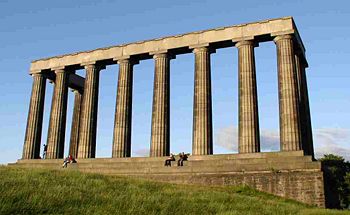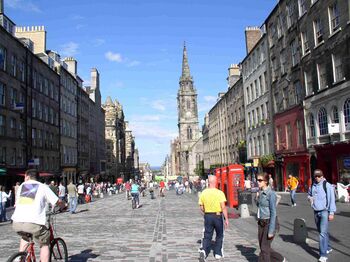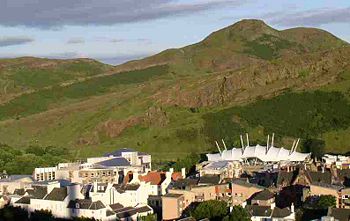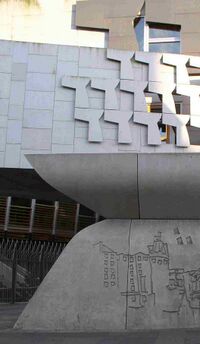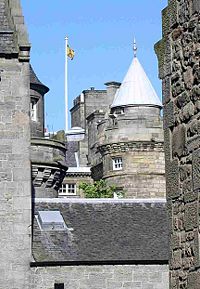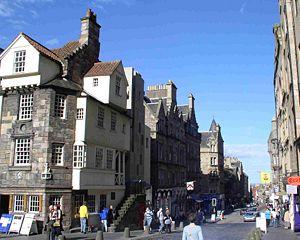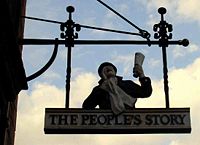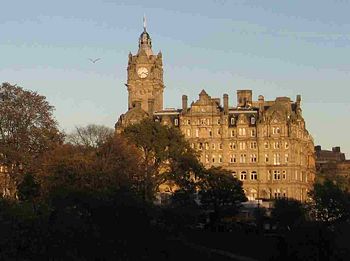Edinburgh
Edinburgh is the capital city of Scotland. In 2001, Edinburgh had a population of 448,624, and has since grown quite rapidly. Edinburgh is also home to the devolved Scottish Parliament.
Edinburgh hosts the Edinburgh International Festival every July, as well as the Fringe festival, the largest festival of performing arts in the world. It has some of the most famous tourist sites in Britain, including Edinburgh Castle, and attracts about 13 million tourists each year. Edinburgh's "Old Town" and "New Town" districts were listed as a UNESCO World Heritage Site in 1995. Edinburgh also hosts the Edinburgh Military Tattoo, the Edinburgh International Film Festival, as well as jazz and book festivals. Other notable events celebrated in Edinburgh include the Hogmanay street party (31 December), Burns Night (25 January), St. Andrew's Day (November 30), and the Beltane Fire Festival (30 April).
The Royal Mile
The Royal Mile is the main street in Edinburgh's Old Town, and runs from Edinburgh Castle to the Royal Palace of Holyrood, a distance of just over a mile. The New Scottish Parliament building is at the foot of the Royal Mile, opposite the Palace. St Giles Cathedral, the High Kirk of Edinburgh, is in Parliament Square on the Royal Mile; its four main pillars are dated to 1190. Just outside the kirk, inset into the pavement is a cobblestone mosaic in the shape of a heart - the "Heart of Midlothian", that marked the entrance to Edinburgh's 15th century tolbooth. Originally an office for collecting tolls, the tolbooth became a prison, with a scaffold outside. Traditionally, prisoners would spit on the door of the tolbooth and this tradition is still preserved as the custom of spitting on the Heart of Midlothian.
Deacon Brodie's Tavern on the Royal Mile perpetuates the memory of Deacon William Brodie (?-1788). Brodie led a double life; he was a qualified wood-worker and a pillar of the community who is known to have met Robert Burns and the painter Sir Henry Raeburn, but also a heavy gambler with five illegitimate children. He began to take wax impressions of the keys to the houses in which he was working, later returning at night to rob them. His double life is said to have been the inspiration for Robert Louis Stevenson's story of "Dr Jekyll and Mr Hyde"
The Royal Mile contains entrances to many small alleys and closes, with picturesque names and often interesting histories. Mary King Close was one such Close. In 1753, development of a new building, the Royal Exchange (designed by John Adam) on the Royal Mile involved building over Mary King Close. The Royal Exchange is now the City Chambers – the administrative centre of the City, and what was once the street level of Mary King Close remained intact, though now completely overbuilt. The Close was forgotten, until in 1928 a council workman discovered an entrance to it. The Close is now open to visitors and is a major tourist attraction, encouraged by convenient tales of haunting.
Arthur's Seat
- Then, as for Arthur's Seat, I'm sure it is a treat
- Most worthy to be seen, with its rugged rocks and pastures green,
- And the sheep browsing on its sides
- To and fro, with slow-paced strides
(from "Edinburgh" by William McGonagall)
In the centre of Edinburgh, enclosed within Holyrood Park (adjacent to the Royal Palace of Holyrood) is Arthur's Seat, the basalt lava plug of a long extinct volcano, last active around 335 million years ago, during the Carboniferous period. The hill rises to a height of 251 m (823 feet), and overlooks Edinburgh's Old Town to the West.
Two stony banks on the east side of Arthur's Seat are the remains of an Iron Age hill-fort. In 1836, seventeen tiny wooden coffins each containing a carved figure were found in a small cave just below the summit. It has been suggested that they may have associations with witchcraft or that they were intended as memorials to the victims of William Burke (1792-1829) and William Hare (1904-ca 1860), who sold bodies for dissection to the anatomist Professor Robert Knox of the Edinburgh Medical College, and turned to murder to satisfy the demand[1]. Burke and Hare murdered at least 16 people and perhaps as many as 30. Burke was hanged on 28th January 1828 (Hare escaped execution by givinig evidence against Burke), and his body was donated to the medical school to be dissected. A pocket-book made from his skin is on display in the Surgeon's Hall Museum of the Royal College of Surgeons of Edinburgh[2], and his skeleton is displayed at the Anatomy Resource Centre of the University of Edinburgh[3].
The Scottish Parliament
When the Scotland Act 1998 was passed by the UK Parliament, it led to the establishment of the first Scottish Parliament since 1707. In 1999, the first members of the new Scottish Parliament were elected. At first, the new Parliament met at the Assembly Hall at the top of The Mound. However, a new building was deemed necessary, and the chosen site was in Holyrood, opposite to the Royal Palace of Holyroodhouse but in an otherwise relatively depressed area of the city. The design for the new Parliament was opened to competition, won by a team led by Spanish architect Enric Miralles. Inspired by the surrounding landscape, the flower paintings of Charles Rennie Mackintosh and the upturned boats on the seashore, Miralles, developed a design that he said was a building "growing out of the land"[4]. The building has proved controversial for many reasons, but particularly because of the way its cost escalated from an initial estimate of £40 million to a final cost of over £420 million. The building has won many award, and attracts strong opinions for and against. The interior is generally thought highly of, and viewed from above it is spectacular, but many dislike the exterior appearance from ground level, an appearance that is not markedly embellished by the concrete bollards and large concrete, bomb-proof walls that were a late addition to parts of the building, prompted by fears of terrorist attacks.
The Old Town
Edinburgh in the 16th century was a walled city enclosing what is now the Old Town; little of the original walls remains, but the street plan of the Old Town is essentially that of the medieval city, and many of its buildings are extremely old. By the end of the 17th century, the relative safety of the city in a generally turbulent country had led it to become both relatively affluent and extremely overcrowded, with a population of about 60,000; bounded to the east by the sea, and to the north by a large lake that had become a large open sewer (the Nor’ Loch) it had little scope to expand. The author Daniel Defoe declared "I believe that in no city in the world so many people have so little room." The city lacked any adequate sanitation (chamber pots were emptied from windows above with the warning cry of Gardy loo! from the French, "Prenez garde a l'eau!"), and was nicknamed “Auld Reekie” after its distinctive smell. Its atmosphere and its large population of prostitutes, itinerants and thieves eventually encouraged its wealthy burghers to plot to abandon the city for a “New Town”, to be built on the fields north of the Nor' Loch.
The New Town
Firm ideas for a New Town emerged after the suppression of the 1745 Jacobite Rising cumulating in the Battle of Culloden in 1746.; in 1746 the City of Edinburgh held a competition, won by 21-year-old architect James Craig, whose initial idea of a ‘patriotic’ street plan in the shape of a Union Jack, developed into a plan for a grid-iron system with 3 main streets - Princes Street, George Street and Queen Street running North-South with the two large, formal squares at either end - St Andrew's Square and St George's Square, renamed Charlotte Square after George's wife Queen Charlotte in 1785.
Thus the Nor’ Loch was drained in 1759, to become what is now Princes Street Gardens, and in 1790 an earthen causeway across the bed of the lake was built (The “Mound”) to connect the Old Town with the new development. The New Town, the first “planned city” development in the world, is now a World Heritage site ; its combination of Gothic and Greek architectural styles aimed to establish Edinburgh as the “Athens of the North” Built to a strict geometric street plan, its stone buildings generally house four floors of apartments, one below street level; the rooms are spacious, high ceilinged and elegant, and now, as then, are very expensive. The architect for many of the most famous buildings was Robert Adam, who designed Register House, (built from 1773 onwards) and Charlottte Square (built in 1791).
The main commercial street of the New Town, Princes Street, runs from The Balmoral Hotel (opened in 1902 as the north British Hotel) in the east to the Caledonian Hotel (opened in 903) in the west. The street was originally named St Giles Street after the patron saint of Edinburgh, and was renamed Princes Street after King George III’s sons (Prince George, the future George IV, and the Duke of York). Few of the buildings on Princes Street itself are particularly noteworthy, but the Department Store Jenners (opened as Kennington & Jenner in 1838) is an old Edinburgh institution. Almost the whole premises of Jenners were destroyed by fire on 26 November 1892, and architect William Hamilton Beattie was commissioned to create a new building, built in the Renaissance style using pink sandstone and lavishly decorated. Jenners was the oldest independent department store in the world until 2005, when it was acquired by the ‘’House of Fraser.’’
Princes Street is developed only on its south facing side, overlooking the Gardens and facing the Old Town, which was abandoned to the prostitutes, the poor, and the generally undeserving elements. On the Mound stand the National Gallery of Scotland and the National Exhibition Centre, two imposing buildings that expressed the cultural pretensions of the Edinburgh elite.
Famous Residents
Edinburgh is home to novelists JK Rowling, [http:www.ianrankin.net Ian Rankin] and Alexander McCall-Smith who is a professor of Medical Law at the University of Edinburgh. JK Rowling began her saga of boy wizard Harry Potter as a single mother, living on benefits, often writing in Edinburgh coffee houses (including the Elephant House on George IV bridge) to save money on heating. Ian Rankin’s novels portray Edinburgh as a dark place of corrupt politicians, small-time gangsters, seedy bars, vandal-ridden housing estates and drug-dealers, in marked contrast to McCall-Smith’s elegant and polite portrayal of a genteel city of middle class affectations.
Edinburgh was also a center of the Scottish Enlightenment, home to many great thinkers such as David Hume and Adam Smith.
Museums and Galleries
- the Palace of Holyroodhouse, founded as a monastery in 1128, is The Queen's official residence in Scotland. Mary, Queen of Scots lived here between 1561 and 1567. Today, the Palace is the setting for State ceremonies and official entertaining, and is open to the public when the Queen is not in residence there. Adjacent to the Palace, the Queens Gallery displays exhibitions of art from the Royal Collection.
- Edinburgh CastleOne of the UK's leading tourist attractions, the Castle's features include St Margaret's Chapel - Edinburgh's oldest building, dating from the 1100s; Crown Square - the main courtyard, developed in the 15th century; The Great Hall with ahammerbeam roof built by James IV; The Half Moon Battery, created in the late 16th century; and The Scottish National War Memorial added after the First World War. The Edinburgh Military Tattoo is held every Summer in the esplanade outside the Castle.
- The City of Edinburgh Museums and Galleries Includes information on The Museum of Childhood and The Writers' Museum.
- The National galleries of Scotland
- National Museum of Scotland Chambers' Street
- National War Museum at Edinburgh Castle
- National Museums Collection Centre Granton
- Surgeons' Hall Museums Royal College of Surgeons of Edinburgh, Nicolson Street
- City Art Centre Holds the City's collection of Scottish Art, and hosts temporary exhibitions.
- Georgian House at 7 Charlotte Square. Owned by the National Trust for Scotland. One of Robert Adam's designs for Charlotte Square, considered a masterpiece of urban architecture, and now restored as a typical 1790-1810 mansion. China, silver, paintings and furniture are on display.
- Gladstone’s Land, in the Lawnmarket, Royal Mile. Owned by the National Trust for Scotland, this is the 17th century tenement home of an affluent merchant.
- Scotch Whisky Heritage Centre on the Royal Mile is an exhibition about the whisky making process.
- The Scott Monument on Princes St. is a 200 ft. high neo-Gothic spire commemorating the poet and novelist Sir Walter Scott(1771-1832) with 64 statuettes of Scott's novels' characters. Four viewing platforms (287 steps by narrow stairs to the top) allow dramatic views of Edinburgh. Scott's novels were enormously popular in the early 19th century, and he is said by some modern scholars to have had a seminal influence on the development of the European novel genre, but his popularity with readers had declined markedly by the end of the 19th century and never recovered.
- John Knox House on the Royal Mile is a town house, built before 1490, displaying exhibits about John Knox, a Protestant leader born between 1505 and 1515, who died at Edinburgh on 24 November, 1572. The house consists of two town houses (or "lands") with the earlier part constructed about 1470 as part of the redevelopment of the city's walls. The exterior of the front house is much the same as that created in 1560. John Knox is a controversial figure in Scotland's history; when the Reformed Protestant religion was ratified by law in Scotland in 1560 he was appointed minister of the Church of St. Giles. His “History of the Reformation” marks him as a leading figure in the Scottish reformation. He was outspoken in his attacks on the Catholic clergy of Scotland, accusing them of being "gluttons, wantons and licentious revelers." According to the Catholic Encyclopedia [5], "permeated with the spirit of the Old Testament and with the gloomy austerity of the ancient prophets, [Knox] displays neither in his voluminous writings nor in the record of his public acts the slightest recognition of the teachings of the Gospel, or of the gentle, mild, and forgiving character of the Christian dispensation."
- Lady Stair’s House/Writer’s Museum on the Royal Mile, displays manuscripts, relics and memorabilia of Robert Burns, Sir Walter Scott and R.L. Stevenson.
- The Museum of Edinburgh, formerly known as Huntly House, occupies 16th and 17th century buildings in the heart of the Old Town. Exhibits include:the feeding bowl and collar belonging to Greyfriars Bobby; the National Covenant, the petition for religious freedom signed by Scotland’s Presbyterians in 1638; and the original plans for Edinburgh’s New Town drawn by architect James Craig.
- The Museum of Childhood on the Royal Mile, displays toys, costumes, books, dolls and games.
- National Gallery of Scotland, Princes St. A collection of European art from 15th century to 19th century.
- National Portrait Gallery Queen St.
- The People's Story is housed in the late 16th century Canongate Tolbooth opposite the Museum of Edinburgh, on The Royal Mile. ' The People's Story ' uses oral history, reminiscence, and written sources to tell the story of the lives, work and leisure of the ordinary people of Edinburgh, from the late 18th century to the present.
- Nelson's Monument at Calton Hill is a 106 ft. tall, tiered, circular tower with viewing gallery overlooking the city. It commemorates Admiral Lord Nelson's victory and death at the battle of Trafalgar on 21 October 1805.
- The Royal Yacht Britannia is moored at Ocean Terminal, Leith.
Hotels
- The George
- The Balmoral Hotel, at the east end of Princes Street
- The Caledonian Hotel, at the west end of Princs Street
